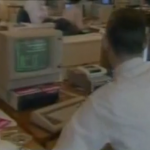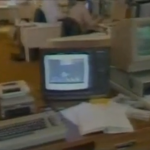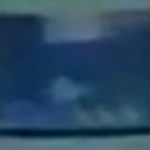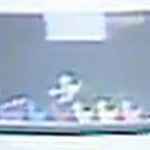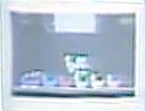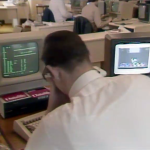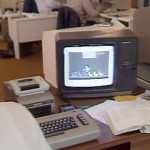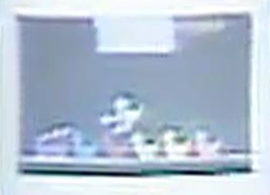
Our next entry is brief, though hope we may well get to find out more soon about it. Whilst at Imagine Software, Colin Porch was busy working on an educational game. He can even be seen working on the very game in the background of Commercial Breaks at one stage, looking pretty stressed!
The basis is pretty sketchy, but Colin so far has recalled a toy train which would go round and off screen, then come back on screen from the other side with a set of shapes (or a single shape) on top. No doubt the user would then be required to choose the name of the shape or answer some kind of question. You can just about make out a train shape on the screenshot we extracted from the video.
Thanks to Mark Jones, we now have a higher quality still of the game – which seems to show some kind of kangaroo object on one of the train carriages. All the carriages are multi-coloured.
That is all we currently know at present, but according to Colin the game was actually finished. But just before anything could be sorted to get the game in the shops, the big crash happened for Imagine, and the game was never picked up by anyone else.
Thanks to Anonymous Contributor, we learn that Colin gave an interview with Retro Robbins in 2023, and spoke about the title:
He mentioned (Anonymous contributor suggests that it was a bit hard to hear at times):
“What I was detailed to do was to produce a game for toddlers and this was effectively, I’d call it a game, it would be a game for them, but it was an exercise in getting toddlers to recognise shapes and colours. At the basic levels, they were just simply trying to match a cross with a cross or a circle with a circle or whatever, all on a moving train.
And in the later stages, they were asked to identify not only the shape but the colour of the shape. There would be two of the same shape but with different colours and you had to match the one they were trying to find. But it wasn’t a game as such, but it was an educational toy, application, for very young people, very young children.”
In an interview that we did with Colin many years ago for our old site (and is now housed at C64.com), he had the following to say about the game and what happened to the disks:
“I worked on two projects whilst at Imagine. The first was a general purpose program, designed to make games programming easier. Originally written in a form of BASIC, the idea was to have a central framework to manipulate sprites etc., onto which individual routines could be added according to a games’ requirements. I did complete it, but I don’t believe that it was ever used.
The second project was not a game but a program aimed at providing toddlers around the three-four age group with shape and colour recognition tasks. This was almost completed, but all the source code was on the SAGE development machine, impounded by the bailiffs when the crash came. I have no idea what happened to it after that.”
Sadly it seems that the game has gone forever along with the disks that Colin sadly skipped back in the mid 2000’s (which was the fate befell to Parasol Stars, or at least its remains). Maybe someone kept a copy from Imagine back then, but it looks very unlikely.
Hopefully we’ll find out more about the game soon!
Contributions: Colin Porch, Paul Drury, Mark Jones, Anonymous Contributor, Retro Robbins
Supporting content
Gallery
Creator speaks
Colin Porch speaks to Paul Drury about the game:
“The educational application that I was doing for Imagine (I would hardly call it a game…) consisted of a train pulling into a station with wagons loaded with different shapes and colours. A Red Triangle, for example, or a blue circle etc. The toddlers it was aimed at had to try to match the load with different shapes and colours on the platform.
I think this was niche in the market Imagine had spotted. It was aimed at toddlers – 3-5 year olds, to get them to match basic shapes and colours. I had a train which would scroll onto the screen carrying a red square or green cross or something and it’d pull up at a station.
On the platform, there’d be several shapes and a station master would walk along, stopping at each shape in turn, and the child pressed the space bar when he stopped by the one that matched.
Once they had selected their choice, and marked “right” or “wrong” the platform “scrolled off”, as did most of the wagons, and they re-appeared again as it pulled into a new station, with a different configuration of shapes. This was repeated as often as desired with the higher levels having more shapes and colours.”
Update history
- 03/10/24 – Interview text added.
- 03/02/15 – Higher quality grabs added thanks to Mark Jones
